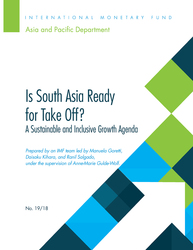
Is South Asia Ready for Take Off?: A Sustainable and Inclusive Growth Agenda
Is South Asia Ready for Take Off?
READ MORE...
Volume/Issue:
Volume 2019
Issue 016
Publication date: November 2019
ISBN: 9781513507538
$20.00
Add to Cart by clicking price of the language and format you'd like to purchase
Available Languages and Formats
| English |
Topics covered in this book
This title contains information about the following subjects.
Click on a subject if you would like to see other titles with the same subjects.
Labor , Economics- Macroeconomics , Demography , DPPP , DP , India , economy , IMF staff calculation , service sector , South Asia region , FDI liberalization , growth strategy , employment elasticity , liberalization path , pro-business reform , reform scenario , export-led growth , Labor force , Income , Productivity , South Asia , Global , Asia and Pacific
Summary
Since the mid-1980s, durable reforms coupled with prudent macroeconomic management have brought steady progress to the South Asia region, making it one of the world’s fastest growing regions. Real GDP growth has steadily increased from an average of about 3 percent in the 1970s to 7 percent over the last decade. Although growth trajectories varied across countries, reforms supported strong per capita income growth in the region, lifting over 200 million people out of poverty in the last three decades. Today, South Asia accounts for one-fifth of the world’s population and, thanks to India’s increasing performance, contributes to over 15 percent of global growth. Looking ahead, the authors find that South Asia is poised to play an even bigger role in the global economy, in both relative and absolute terms. India has overtaken China as the fastest growing large economy and South Asia’s contribution to global growth is set to increase, while more mature economies decelerate. Greater economic diversification, with an expansion of the service sector, improvements in education, and a still sizable demographic dividend are among the key elements underpinning this performance. Based on demographic trends, more than 150 million people in the region are expected to enter the labor market by 2030. This young and large workforce can be South Asia’s strength, if supported by a successful high-quality and job-rich growth strategy. Amid a changing global economic landscape, the authors argue that South Asia will need to leverage on all sectors of the economy in a balanced way, supporting improvements in agricultural productivity and a sustainable expansion of manufacturing, while promoting higher-skill services, to achieve this goal.
Copyright © 2010 - 2025
Powered by:
AIDC



